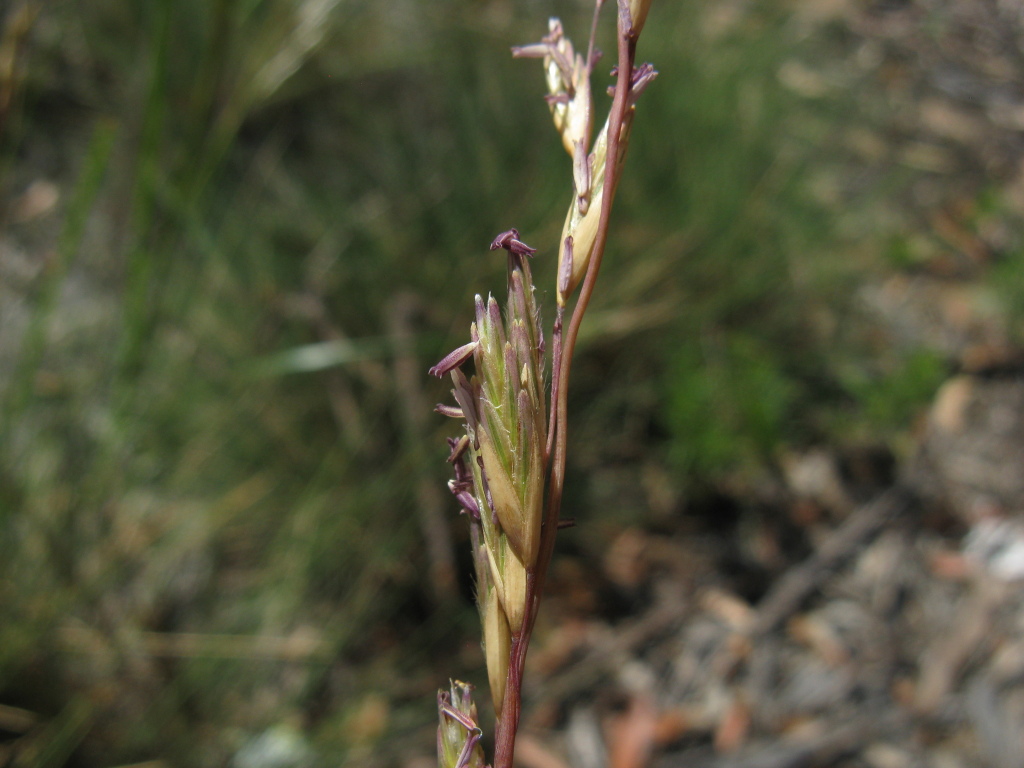Triodia scariosa
N.T.Burb. Porcupine GrassRobust tufted perennial, old plants often forming rings, culms erect, to 2 m high. Leaves rigid, glabrous or nearly so; blade closely inrolled except near base, spreading from axis, needle-pointed, to 20cm long and 1 mm diam.; sheath stem-clasping, sometimes slightly glaucous; ligule ciliate, c. 0.5 mm long; inflorescence a narrow panicle 10–30 cm long. Spikelets narrowly oblong, 4–14-flowered, distichous, 10–20 mm long; glumes acute, subequal, 5–12 mm long; lemmas oblong to narrowly ovate, 5–10 mm long, emarginate or erose at apex, with or without a short mucro; lemma surface smooth to minutely scabrous, with silky hairs covering the lower part and along the midrib for up to c. two-thirds its length; palea oblong, shorter than by c. 1 mm or slightly exceeding lemma. Flowers Aug.–Feb. (mostly Sep.–Nov.)
LoM, MuM, Wim, GleP, Brid, RobP, MuF, GipP, OtP, GGr, DunT. Also WA, SA, Qld, NSW. Occurs on both red and yellow sands in mallee communities in the far north-west where locally dominant, with isolated southerly occurrences in and near the Grampians and in the lower Glenelg area near the SA border.
Jacobs (1992) included T. irritans R.Br. var. laxispicata N.T.Burb. within T. scariosa after finding the types of the two were identical, and recognised a new subspecies, Triodia scariosa subsp. bunicola S.W.L. Jacobs (later elevated to T. bunicola (S.W.L.Jacobs) Lazarides). The differences between Victorian plants previously referred to these entities (i.e. lemmas firmer, broader and minutely scabrous in T. irritans var. laxispicata and glumes and lemmas firmer and the florets more closely overlapping in T. bunicola) have been shown to be attributable to variation within T. scariosa (Hurry et al. 2012). Triodia irritans var. compacta N.T.Burb. has been demonstrated to be a distinct entity (raised to specific rank, T. compacta (N.T.Burb.) S.W.L.Jacobs) of restricted occurrence in South Australia. Reported occurrences of this species in Victoria have been based on misinterpretation of features.
Walsh, N.G. (1994). Poaceae. In: Walsh, N.G.; Entwisle, T.J., Flora of Victoria Vol. 2, Ferns and Allied Plants, Conifers and Monocotyledons, pp. 356–627. Inkata Press, Melbourne.
 Spinning
SpinningHurry, C.R.; Walsh, N.G.; Murphy, D.J. (2012). A taxonomic review of Triodia bunicola and T. scariosa (Poaceae: Chloridoideae), based on morphological and molecular data. Australian Systematic Botany 25(5): 304–312.
Jacobs, S.W.L. (1992). Notes on Australian grasses: New taxa and a new combination in Triodia (Poaceae). Telopea 4: 653–659.




